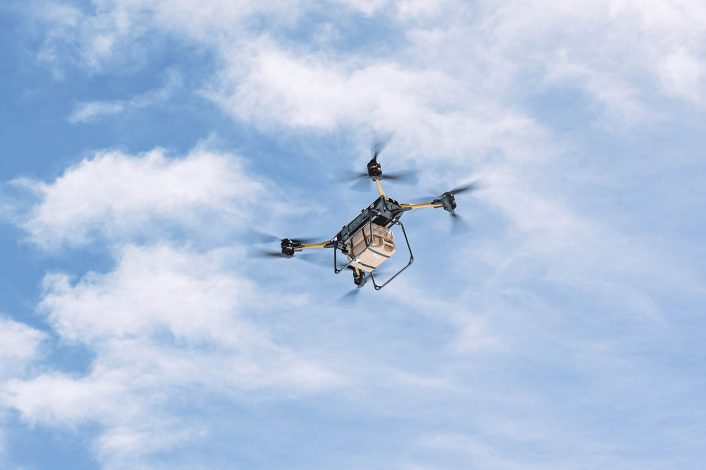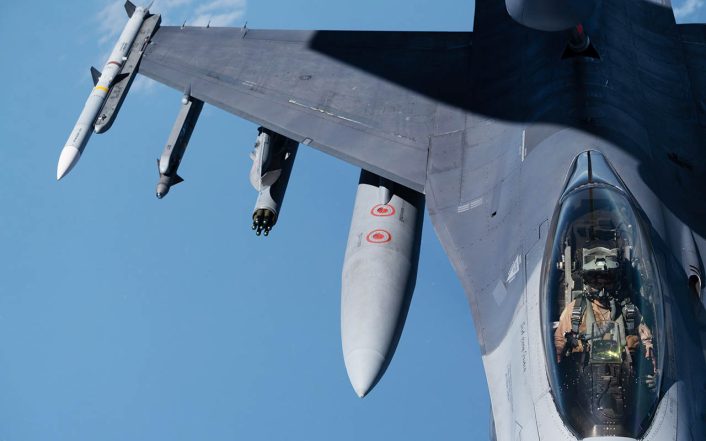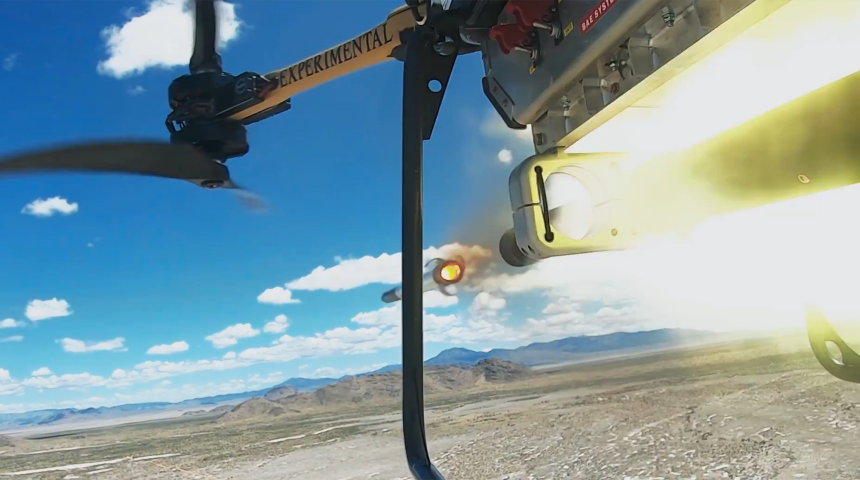Munitions equipped with the Advanced Precision Kill Weapon System (APKWS) laser guidance kit were fired at both land and air targets from a modified variant of Malloy Aeronautics’ T-150 octocopter.
The test launches were carried out at Dugway Proving Ground in Utah using a truck and a small fixed wing drone as targets. All launches were said to score direct hits.
Developed by British firm Malloy Aeronautics, which is now owned by BAE Systems, the T-150 is designed as a cargo carrying drone and in fact is presently deployed in that role with the UK’s Carrier Strike Group. The TRV-150 is a U.S. Marine Corps specific variant of the system with some adaptations to suit the customer, and it has already seen some use in the field.

The vehicle features eight rotors driven by electric motors, offering a payload up to 68 kilograms and a maximum range (depending on payload) between 8 and 45 kilometres.
Malloy is partnering with SURVICE Engineering to deliver the drones to the USMC. “While originally designed as a tactical edge logistics drone, adding strike packages to different variants of the TRV is a natural extension that leverages an already-fielded UAS as a multi-role offensive and defensive asset,” noted SURVICE Engineering President Greg Thompson. “Providing medium UAS-delivered air and ground target strike capability will be a force-multiplying game changer and we are excited to play a role in bringing this new capability to our US and allied-nation warfighters.”
Video footage released of the test depicts the TRV-150 carrying and firing a single munition, though it appears that the current form taken by the launching rig could accommodate three missiles. While not competitive with traditional Hydra 70 launcher pods, which usually carry either 9 or 17 rounds per pod, drones have the advantage of being small and relatively inexpensive, thereby allowing more to be deployed.
From drawing board to demonstration in a few months. We’ve integrated the APKWS munition with the TRV-150, achieving a 100% strike rate.
The T-150 is low-cost and easy to deploy. This strike and C-UAS capability adds another role to this proven and versatile platform.
— BAE Systems Air (@BAESystemsAir) July 17, 2025
The TRV-150 could be deployed alongside ground forces to provide an organic aerial strike capability to units that would otherwise have had to request air support. It could also be fielded on board ships to act as an extra layer of defence against smaller threats on the water or in the air. As control technologies advance, the drones could be deployed autonomously in response to a detected threat in a similar fashion to a close-in weapons system (CIWS) like Phalanx or SeaRAM.
When requirements shift, the drones would almost certainly be able to be reconfigured back to a logistics role in a short space of time – likely just with a swap of loadouts.
Anthony Gregory, Business Development Director for BAE Systems FalconWorks – the company’s advanced research and development division – said uncrewed systems are of growing importance in their customers’ requirements. He added: “These trials have significantly advanced our ability to deliver this new tactical option at a fraction of the cost of conventional means, showcasing that we continue to address the challenges of tomorrow through innovation and collaboration.”
APKWS
APKWS was introduced into service in 2012 as a way of upgrading the venerable Hydra 70 unguided rocket – itself based on a Second World War design – with a precision guidance capability, enabling it to stay relevant in modern battlefields where collateral damage is a major concern. The guidance system has since been tested on other unguided rockets.
Initial visions would have seen APKWS primarily used against lightly armored ground vehicles as well as small surface watercraft, offering a comparatively inexpensive way of neutralising these threats that can also be carried in great numbers by existing platforms. It has since evolved further as an air to air counter-drone weapon, deployed on fighter aircraft like the F-15E Strike Eagle and F-16 Fighting Falcon.

The guidance package is in receipt of constant upgrades, now boasting a dual-mode capability with both laser and infrared guidance. The latter would be very beneficial for use on the TRV-150 as it eliminates the requirement for a target to be lased constantly until the missile hits. Many other aircraft that carry APKWS are able to lase a target themselves with their integrated targeting systems, or underslung pods, but the TRV-150 (as it stands) does not offer this capability. A laser would have to be provided by an external source in order for laser guidance to function.
At present, the infrared mode apparently requires a target to be lased for acquisition before the missile switches to infrared guidance. It’s possible this requirement could be removed in future updates (if it hasn’t already), allowing acquisition using the missile’s seeker much like a traditional infrared guided air to air missile.
Similar Developments
Though the TRV-150 is, at its heart, a British design, the UK has gone down a different route for UAS launched guided rockets. A futuristic looking vertical take-off and landing drone known as Jackal was used in 2022 to test fire Lightweight Multirole Missiles – designated Martlet in UK service.
Watch the Jackal drone launch Martlet missiles for first the time during trials 💥
The drone is the first to fire a competent missile, that can have a lethal effect, at a hover in flight.
Find out more here 👉 https://t.co/Vtsfh9vbbx pic.twitter.com/BALNlIvYMy
— BFBS Forces News (@ForcesNews) April 19, 2023
The Martlet shares a development history with the Starstreak surface to air missile, and was ordered to equip the Royal Navy’s Wildcat HMA2 helicopters. Complementing the Sea Venom anti-ship missile, Martlet would be used to counter smaller threats much like APKWS.
The missile has since been tested from land and sea platforms, and operationally deployed on the frontlines in Ukraine mounted on surplus British Army Stormer HVM air defence vehicles. Stormer HVM’s primary ammunition is the Starstreak missile, but the two systems’ similar designs mean they can share launcher systems.
Exercises in late 2024 proved the missile’s air to air capabilities from the Wildcat as defence against drones became a high priority following experiences in the Red Sea. Wildcat helicopters equipped with Martlet have since been placed on round-the-clock alert to protect HMS Prince of Wales and its strike group as they transited through the Middle East.
Martlet missiles are unloaded and reloaded onto the Wildcat helicopter @HMSDauntless in a routine deck cycle every 12 hours when held at high readiness #CSG25 pic.twitter.com/T42EwBA4Il
— Navy Lookout (@NavyLookout) June 16, 2025
As well as the Jackal, Martlet has also been shown as a carriage option for the Camcopter S-100. This drone is now in active Royal Navy service as Peregrine, in an intelligence, surveillance and reconnaissance mode. Its potential offensive capabilities have yet to be exploited but are likely to remain on the table.









